Microalgae have recently attracted considerable interest worldwide, due to their extensive application potential in the renewable energy, biopharmaceutical, and nutraceutical industries. Microalgae are renewable, sustainable, and economical sources of biofuels, bioactive medicinal products, and food ingredients. Several microalgae species have been investigated for their potential as value-added products with remarkable pharmacological and biological qualities. As biofuels, they are a perfect substitute for liquid fossil fuels with respect to cost, renewability, and environmental concerns. Microalgae have a significant ability to convert atmospheric CO2 to useful products such as carbohydrates, lipids, and other bioactive metabolites. Although microalgae are feasible sources for bioenergy and biopharmaceuticals in general, some limitations and challenges remain, which must be overcome to upgrade the technology from the pilot phase to the industrial level. Are microalgae the future of sustainable nutrition? Are they more efficient than traditional crops? These are just some of the questions we will answer, so let’s dive in and find out.
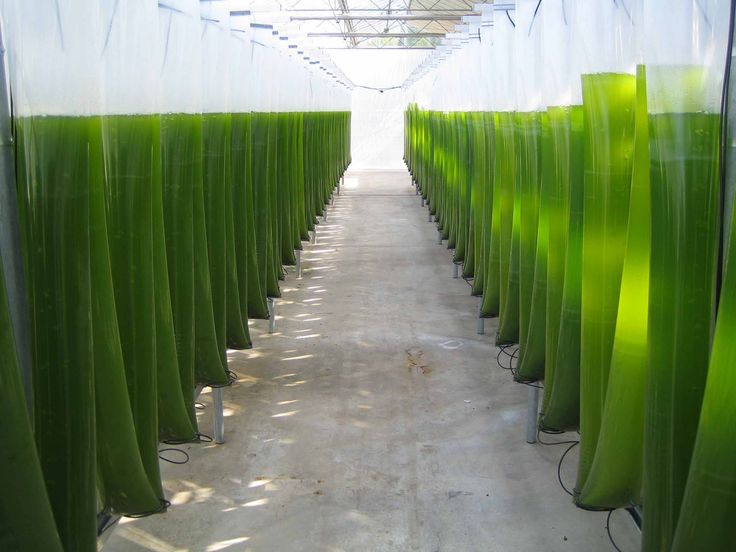
Sustainability of Microalgae Cultivation
Microalgae, tiny, photosynthetic microorganisms, can be cultivated in a variety of conditions, including brackish water, wastewater, and even saline or arid environments. Their ability to thrive in such diverse conditions makes them highly sustainable. Unlike traditional crops, microalgae don’t require arable land, freshwater, or chemical fertilizers. Additionally, their rapid growth rates mean they can be harvested multiple times a year. This reduces the need for deforestation and minimizes the environmental footprint associated with agriculture.

Potential of Microalgae for Sustainable Biofuel Production
Algal biomass contains three main components: carbohydrates, proteins, and lipids/natural oils. Because the bulk of the natural oil made by microalgae is in the form of tricylglycerol , which is the right kind of oil for producing biodiesel, microalgae are the exclusive focus in the algae-to-biodiesel arena.Some algal species can produce hydrogen gas under specialized growth conditions. The biomass from algae can also be burned similar to wood or anaerobically digested to produce methane biogas to generate heat and electricity. Algal biomass can also be treated by pyrolysis to generate crude bio-oil. The promise lies in their high oil content and fast growth, which makes them a potential sustainable source of biofuels. The use of microalgae for biofuel production can reduce our dependence on fossil fuels and decrease greenhouse gas emissions

Microalgae as Feed Supplements for Sustainable Aquaculture
The aquaculture industry faces a significant challenge in sourcing sustainable and nutrient-rich feed for fish and shellfish. Microalgae can play a crucial role here. They are a natural part of many aquatic organisms’ diets and are packed with essential nutrients. Cultivating microalgae to supplement aquaculture feed can reduce the reliance on wild-caught fish for fishmeal, conserving marine ecosystems and making aquaculture more sustainable.

Sustainable Development Goals of Microalgae
The use of microalgae aligns with several Sustainable Development Goals (SDGs), including:
Zero Hunger: Microalgae can contribute to food security and provide a nutrient-rich source of food.
Clean Water and Sanitation: Microalgae can help purify wastewater and convert it into valuable biomass.
Affordable and Clean Energy: Through biofuel production, microalgae contribute to sustainable energy solutions.
Life Below Water: Microalgae support healthy marine ecosystems by reducing pressure on wild fish stocks.
Climate Action: Microalgae can mitigate carbon emissions and provide a sustainable source of renewable energy.
Are Algae the Future of Sustainable Nutrition?
Microalgae are a nutritional powerhouse, rich in proteins, essential fatty acids, vitamins, and minerals. Spirulina and Chlorella, two well-known microalgae, are already being used as dietary supplements. They have the potential to be a significant source of sustainable and nutrient-dense food for humans. With their efficient growth, they can be produced on a large scale without straining resources.


Algae production
Potential yields
Depending on the culture systems used (opens ponds vs.enclosed photobioreactors), microalgae production yield is expressed as the amount of biomass per unit of surface area (for open ponds), or per unit of reactor volume (for enclosed photobioreactors). A typical open pond can produce 5 to 10 grams of biomass (dry basis) per m2 of surface area per day, which translates to 7.4 to 14.8 tons (dry biomass) per acre per year. Some researchers reported that biomass yield can be as high as 50 g/m2 per day, i.e., 74 ton biomass/m2 per year in an open pond. For enclosed photobioreactors, the biomass yield can be approximately 2 to 3 gram/L per day, i.e., 0.73-1.05 ton (dry biomass)/m3 per year. The oil content of the dry biomass is a highly variable parameter , while some strains can reach as high as 80 percent . Table 2 lists the potential yields of oil produced by various crops and compares these values to oil yields from an open pond growing microalgae.
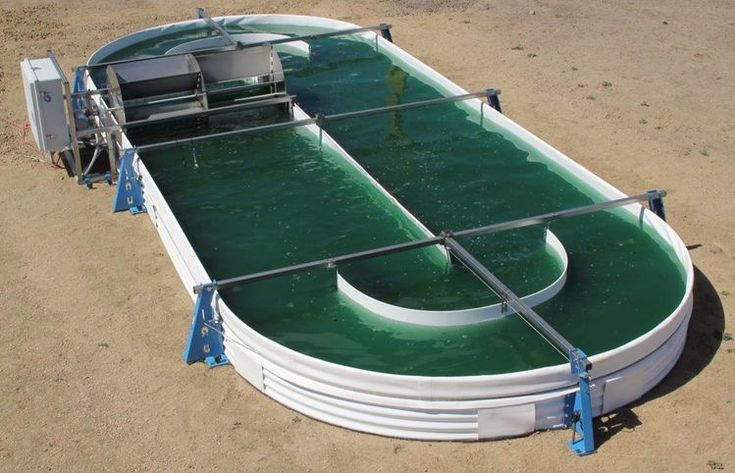
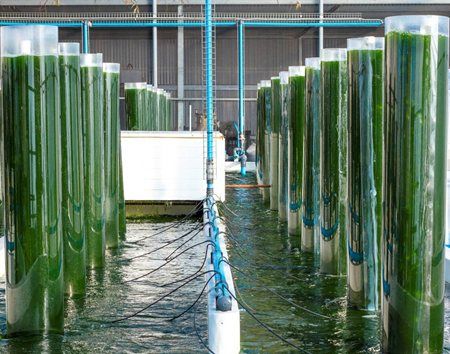

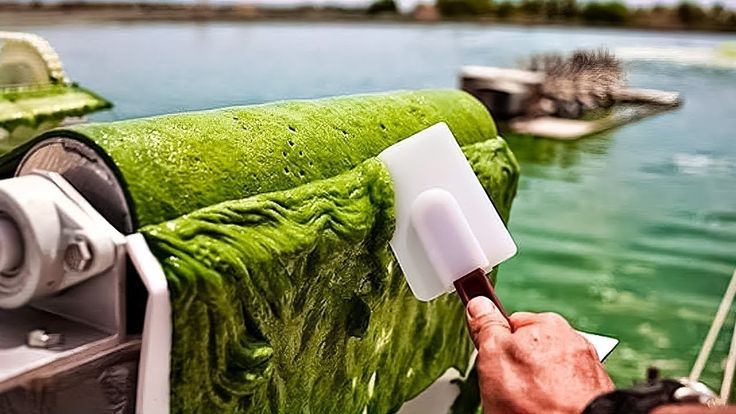
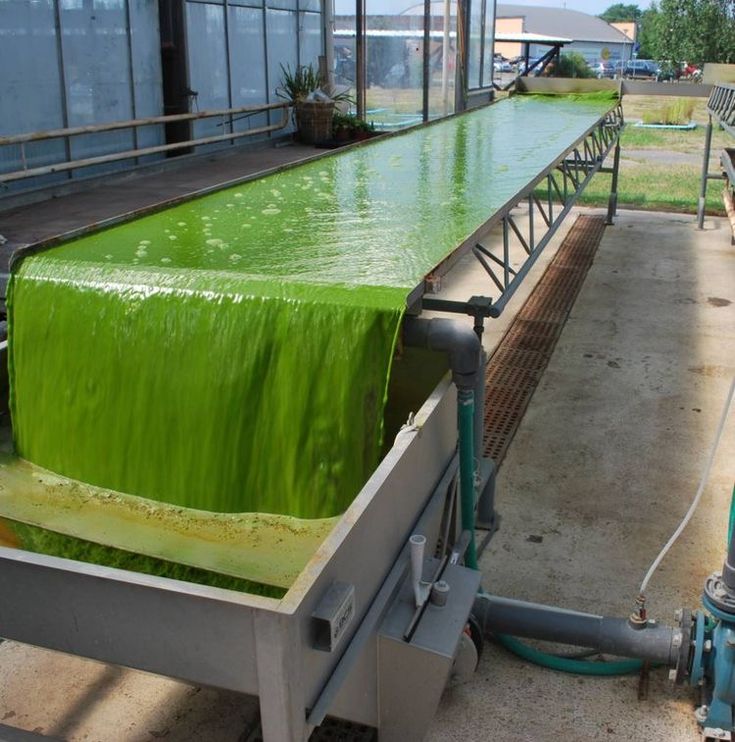
Production challenges
In recent years, algal biofuel production has gained renewed interest.Start-up businesses are researching and developing new methods to improve the algal process efficiency with a final goal of commercial algal biofuel production. The research and development efforts can be categorized into several areas:
- Increasing oil content of existing strains or selecting new strains with high oil content.
- Increasing growth rate of algae.
- Developing robust algal-growing systems in either an open-air environment or an enclosed environment.
- Co-product development other than the oil.
- Using algae in bioremediation.
- Developing an efficient oil-extraction method.
One way to achieve these goals is to genetically and metabolically alter algal species. The other is to develop new or improve existing growth technologies so that the same goals listed above are met. However, it should be noted that this new wave of interest has yet to result in a significant breakthrough

Production cost
The production cost of the algal oil depends on many factors such as the yield of biomass from the culture system, the oil content, the scale of production systems, and the cost of recovering oil from algal biomass. Currently, algal oil production is still far more expensive than petroleum diesel fuels. For example, Chisti (2007) estimated the production cost of algae oil from a photobioreactor with an annual production capacity of 10,000 tons per year. Assuming the oil content of the algae to be around 30 percent, the author determined a production cost of $2.80/L ($10.50/gallon) of algal oil. This estimation did not include the costs of converting algal oil to biodiesel, or the distribution and marketing cost for biodiesel and taxes. At the same time, the petroleum diesel price was $2.00 to $3.00 per gallon and today is 4.50 to 5.50 per gallon.
Whether algal oil can be an economic source for biofuel in the future is still highly dependent on the petroleum oil price. Chisti (2007) used the following equation to estimate the cost of algal oil where it can be a competitive substitute for petroleum diesel where Calgal oil is the price of microalgal oil in $/gallon, and Cpetroleum is the price of crude oil in $/barrel:
Calgal oil = 25.9 x 10-3 Cpetroleum
This equation assumes that algal oil has roughly 80 percent of the caloric energy value of crude petroleum. For example, with petroleum price at $100/barrel, algal oil should cost no more than $2.59/gallon in order to be competitive with petroleum diesel.
Is Algae Production Sustainable?
Compared to traditional agriculture, microalgae production is highly sustainable. It reduces the pressure on land and freshwater resources, minimizes the use of chemical inputs, and can thrive in various environments. Additionally, microalgae are capable of capturing CO2, thus helping to combat climate change.

Are Algae More Efficient Than Plants?
Microalgae are incredibly efficient at photosynthesis, converting sunlight into biomass much more rapidly than land-based plants. Their high growth rates and ability to capture CO2 make them a promising candidate for sustainable agriculture, especially in regions with challenging environmental conditions.But of course it will never replace general agricultural crops.

Conclusion
Microalgae are tiny factories and renewable, sustainable, and economical sources of biofuels, bioactive medicinal products, and food ingredients. Microalgae are useful in the mitigation of elevated CO2 levels and the treatment of wastewater. Upgradation of algal fuel and bioproducts technology from pilot scale to commercial level is possible by overcoming the associated challenges and limitations. In this review, we describe the extensive applications of microalgae in bioenergy, nutraceutical, and pharmaceutical industries, the associated challenges and limitations, and how they can be overcome to make them feasible and viable for commercialization.